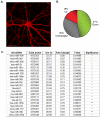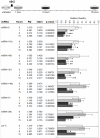Neuronal microRNA deregulation in response to Alzheimer's disease amyloid-beta
- PMID: 20552018
- PMCID: PMC2884018
- DOI: 10.1371/journal.pone.0011070
Neuronal microRNA deregulation in response to Alzheimer's disease amyloid-beta
Abstract
Normal brain development and function depends on microRNA (miRNA) networks to fine tune the balance between the transcriptome and proteome of the cell. These small non-coding RNA regulators are highly enriched in brain where they play key roles in neuronal development, plasticity and disease. In neurodegenerative disorders such as Alzheimer's disease (AD), brain miRNA profiles are altered; thus miRNA dysfunction could be both a cause and a consequence of disease. Our study dissects the complexity of human AD pathology, and addresses the hypothesis that amyloid-beta (Abeta) itself, a known causative factor of AD, causes neuronal miRNA deregulation, which could contribute to the pathomechanisms of AD. We used sensitive TaqMan low density miRNA arrays (TLDA) on murine primary hippocampal cultures to show that about half of all miRNAs tested were down-regulated in response to Abeta peptides. Time-course assays of neuronal Abeta treatments show that Abeta is in fact a powerful regulator of miRNA levels as the response of certain mature miRNAs is extremely rapid. Bioinformatic analysis predicts that the deregulated miRNAs are likely to affect target genes present in prominent neuronal pathways known to be disrupted in AD. Remarkably, we also found that the miRNA deregulation in hippocampal cultures was paralleled in vivo by a deregulation in the hippocampus of Abeta42-depositing APP23 mice, at the onset of Abeta plaque formation. In addition, the miRNA deregulation in hippocampal cultures and APP23 hippocampus overlaps with those obtained in human AD studies. Taken together, our findings suggest that neuronal miRNA deregulation in response to an insult by Abeta may be an important factor contributing to the cascade of events leading to AD.
Conflict of interest statement
Figures



Similar articles
-
Deregulation of neuronal miRNAs induced by amyloid-β or TAU pathology.Mol Neurodegener. 2018 Oct 12;13(1):54. doi: 10.1186/s13024-018-0285-1. Mol Neurodegener. 2018. PMID: 30314521 Free PMC article.
-
Selected microRNAs Increase Synaptic Resilience to the Damaging Binding of the Alzheimer's Disease Amyloid Beta Oligomers.Mol Neurobiol. 2020 May;57(5):2232-2243. doi: 10.1007/s12035-020-01868-8. Epub 2020 Jan 29. Mol Neurobiol. 2020. PMID: 31997075 Free PMC article.
-
Target gene repression mediated by miRNAs miR-181c and miR-9 both of which are down-regulated by amyloid-β.J Mol Neurosci. 2012 Feb;46(2):324-35. doi: 10.1007/s12031-011-9587-2. Epub 2011 Jul 1. J Mol Neurosci. 2012. PMID: 21720722
-
MicroRNA networks surrounding APP and amyloid-β metabolism--implications for Alzheimer's disease.Exp Neurol. 2012 Jun;235(2):447-54. doi: 10.1016/j.expneurol.2011.11.013. Epub 2011 Nov 16. Exp Neurol. 2012. PMID: 22119426 Review.
-
MicroRNA in Alzheimer's disease revisited: implications for major neuropathological mechanisms.Rev Neurosci. 2018 Feb 23;29(2):161-182. doi: 10.1515/revneuro-2017-0042. Rev Neurosci. 2018. PMID: 28941357 Review.
Cited by
-
MicroRNA dysregulation in the spinal cord following traumatic injury.PLoS One. 2012;7(4):e34534. doi: 10.1371/journal.pone.0034534. Epub 2012 Apr 12. PLoS One. 2012. PMID: 22511948 Free PMC article.
-
MicroRNAs in Neurotoxicity.J Toxicol. 2012;2012:870150. doi: 10.1155/2012/870150. Epub 2012 Mar 6. J Toxicol. 2012. PMID: 22523492 Free PMC article.
-
Bias in microRNA functional enrichment analysis.Bioinformatics. 2015 May 15;31(10):1592-8. doi: 10.1093/bioinformatics/btv023. Epub 2015 Jan 20. Bioinformatics. 2015. PMID: 25609791 Free PMC article.
-
Differential DNA Methylation of MicroRNA Genes in Temporal Cortex from Alzheimer's Disease Individuals.Neural Plast. 2016;2016:2584940. doi: 10.1155/2016/2584940. Epub 2016 Apr 26. Neural Plast. 2016. PMID: 27213057 Free PMC article.
-
A combined miRNA-piRNA signature to detect Alzheimer's disease.Transl Psychiatry. 2019 Oct 7;9(1):250. doi: 10.1038/s41398-019-0579-2. Transl Psychiatry. 2019. PMID: 31591382 Free PMC article.
References
-
- Rovelet-Lecrux A, Hannequin D, Raux G, Le Meur N, Laquerriere A, et al. APP locus duplication causes autosomal dominant early-onset Alzheimer disease with cerebral amyloid angiopathy. Nat Genet. 2006;38:24–26. - PubMed
-
- Podlisny MB, Lee G, Selkoe DJ. Gene dosage of the amyloid beta precursor protein in Alzheimer's disease. Science. 1987;238:669–671. - PubMed
-
- Gotz J, Schild A, Hoerndli F, Pennanen L. Amyloid-induced neurofibrillary tangle formation in Alzheimer's disease: insight from transgenic mouse and tissue-culture models. Int J Dev Neurosci. 2004;22:453–465. - PubMed
Publication types
MeSH terms
Substances
LinkOut - more resources
Full Text Sources
Other Literature Sources
Medical
Molecular Biology Databases

